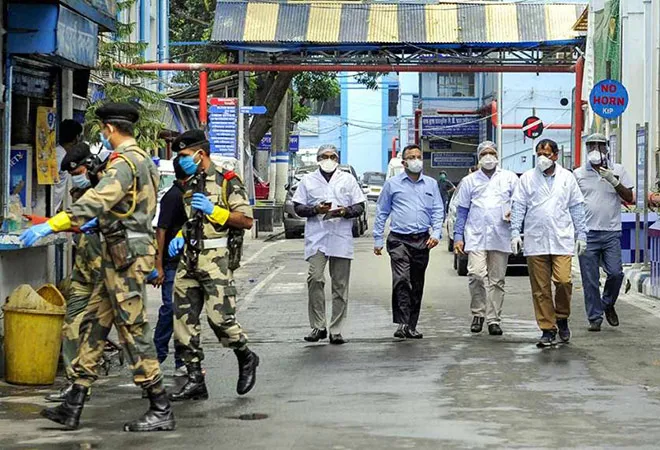-
CENTRES
Progammes & Centres
Location

SARS-CoV-2, the virus that causes COVID-19, has now spread across the world. As of the last week of May, about 5.5 million laboratory-confirmed cases, including 343,514 deaths, have been reported from 213 countries. The doubling rate of the total recorded cases in parts of South America and sub-Saharan Africa has reduced in recent weeks, indicating the pandemic is on an upswing.
The pandemic is ongoing in countries like the Democratic Republic of the Congo, Panama, and Paraguay, all with average temperatures over 25°C. Ecuador, a country with similar climatic conditions as India has emerged as a major centre of the epidemic in South America. Singapore, with its humid, tropical climate, continues to see cases. These observations suggest that elevated temperatures are insufficient to slow epidemic spread.
Early studies looking at data from Wuhan and other parts of China used regression models to suggest that the virus would transmit better in cold, dry weather. However, these models were based on the limited data available at that time. Also, ecological studies such as these are indicative but the causality is impossible to establish as regional differences are important confounders. At least one study that examined the effects of absolute humidity and temperature on the number of cases throughout China warned that in the absence of public health interventions, rising temperatures and increasing humidity alone would not prevent an increase in the number of cases.
To better understand the impact of seasonality on the spread of viral diseases, since the pandemic was initiated in the early spring in India but will spill over into summer and the monsoon season, we need to ask, separately: What do we know about the effects of changing seasons on the pandemic in its current phase as well as what might happen next, in the post-pandemic phase?
During the initial stages of the pandemic, when the SARS-CoV-2 virus initially spilled over into the human population and first began to spread across Southeast Asia and then Europe and the Americas, the role of seasonality was barely apparent. Simulations based on available data about seasonality from influenza virus and the two beta-coronaviruses (the family of viruses to which SARS-CoV-2 belongs) OC43 and HKU1, combined with the Basic Reproductive Number (R0) for SARS-CoV-2 were used to compare outbreak sizes in nine cities across the world. No difference in predicted pandemic size was seen between Delhi, New York and London. This model only suggested a small delay in the peak of the pandemic between the Northern and Southern hemispheres.
Further, the initial simulations suggested that humidity could modulate pandemic size (based on data from New York) but eventually concluded that these effects were small. However, there is some evidence to suggest that while taking seasons into account, the pandemic size can bemainly influenced by when to impose the control measure and when to lift the same. This is not unreasonable since contact patterns between individuals do vary across seasons, particularly in temperate climates. Other studies have suggested that seasonality in combination with infection control measures can result in a temporary reduction in cases. However this does not suggest the pandemic can be fully contained with these measures.
Some modelling studies have suggested that over time, much like endemic viruses such as influenza virus and other beta-coronaviruses, SARS-CoV-2 may also display a seasonal pattern. This will be influenced by whether or not people who are infected become immune to reinfection by the virus and by how long they stay protected, as well as by the introduction of new susceptible into the population, through births or migration from other regions. These models suggest that SARS-CoV-2 is here to stay and also indicate that in the coming future we may see recurrent outbreaks of the virus (2025 in some simulations) with some possibility of settling into seasonal cycles.
A major caveat of all the studies outlined above is that they do not take into account population movement, immunity to SARS-CoV-2, and the local milieu, including the willingness of the population to adopt control measures such as the wearing of masks. The movement of populations in a hyper-connected world can also disrupt simple seasonal patterns.
SARS-CoV-2 is a new virus and all human beings appear to be susceptible to it. The virus is mutating, but the mutation rate appears to be at least a factor of 4 lower than for seasonal influenza. There is very little evidence that any current strain of the virus is more virulent than another. This suggests that environmental, epidemiological and social factors are more likely to influence the spread at this stage. These factors can be influenced by the monsoons and may play a role in the number of cases seen in India.
Modelling studies predict that even with all the measures in place, the number of cases in India is likely to rise and peak in June-July 2020<1>. However, these studies do not take into account any modulation due to seasonality and only reflect the natural history of the disease. At present, since the daily increase in the number of confirmed cases have remained constant or have marginally increased, this suggests India hasn’t neared the peak yet. as
How temperature and humidity influence transmission in the Indian context is still unknown. At the moment, without this data, there is very little scope to understand the impact of different seasons on the virus.
The virus is transferred between individuals via aerosols as well as bigger droplets, emitted when someone infected coughs or sneezes. Aerosols are small particles of fluid containing viruses that are light enough to remain suspended in the air for several hours. Droplets are larger and can fall to the ground in minutes. The stability of the droplets containing the virus is likely to be influenced by change in climatic conditions, since how droplets containing virus particles grow bigger or smaller is determined by the humidity as well as the temperature.
Another route to infection is via fomites, passive objects or surfaces that might be touched first by an infected person and later by someone who is susceptible. The viability of the virus on surfaces is affected by temperature, however we do not know how this will be influenced by the monsoons.Under highly humid conditions, condensation might actually help to clear the virus from surfaces.
The possibility of fecal transmission (feco-oral, feco-respiratory) has also been highlighted with the presence of viable virus in faeces of a COVID-19 patient. Previously, only the presence of viral RNA had been reported in faeces. These findings are preliminary and the contribution of this mode of transmission will only emerge over time. This remains a concern for low-sanitation regions in the developing world.
The relative importance of these modes by which the virus can be transmitted is currently a topic of investigation and how these effects might synergize to influence the transmission of SARS-CoV-2 during the monsoons is unknown.
Transmission during the monsoon is also likely to be influenced by the social behaviour of susceptible individuals. We know little about how an ongoing epidemic might play out in the background of a natural disaster like cyclone Amphan, but increased crowding in the relief camps that have been set up may provide an easy route to spread. A big unknown is how the presence of other diseases such as dengue and malaria will influence COVID-19 and vice versa.
Finally, as the monsoons arrive, there is usually a surge in both vector -borne and water-borne diseases including dengue, chikungunya, malaria as well as typhoid. This year they are also likely to meet a strained public health system, an already stressed population and severe infrastructural constraints.
A complex set of factors, some of which could balance or counter others, are likely to influence the number of SARS-CoV-2 cases during monsoon. From what we know right now, it appears impossible to predict whether the monsoon will contribute to an increase or decrease in the number of cases. All models predict that the first wave in India should reach its peak across July, perhaps August under normal circumstances, in which the monsoon and the summer season are not accounted for explicitly. The natural progression of the disease suggests that cases will keep increasing for another month or more in most models. We are almost six months into the pandemic, and both models and observations from different countries suggest that recurrent outbreaks of SAR-CoV-2 are likely, possibly for the next two years. It is therefore crucial that while we cope with the pandemic, we also prepare for vector-borne diseases tied to the monsoon season, as these are significant contributors to morbidity and mortality in India.
<1> From an ongoing study: INDSCI-SIM A state-level epidemiological model for India by Snehal Shekatkar, Bhalchandra Pujari, Mihir Arjunwadkar, Dhiraj Kumar Hazra, Pinaki Chaudhuri, Sitabhra Sinha, Gautam I Menon, Anupama Sharma VG
The views expressed above belong to the author(s). ORF research and analyses now available on Telegram! Click here to access our curated content — blogs, longforms and interviews.

Dr. Chitra Pattabiraman is a virologist/molecular biologist who uses genomic tools (sequencing) to identify and characterize pathogens. She obtained her Integrated MSc- PhD in Life ...
Read More +
Gautam I Menon is a Professor of Physics and Biology at Ashoka University
Read More +